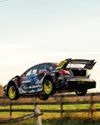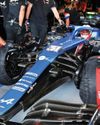
Readers might remember that in Racecar Engineering V28N5 we featured the Hartley V12, a naturally aspirated V12 engine, based on 5.0-litre Toyota castings, which produces about 750bhp at 9500rpm.
Since then, the Palmerston North, New Zealand-based company behind it has produced a second version of this potent powerplant, designated Prototype Number 2, which has twin turbochargers and is estimated to produce upwards of 1500bhp on full boost, and a more modest 1050bhp at 12psi of boost pressure.
While the figures for both units are impressive, equally noteworthy is the way they are produced. This is because, in order to speed up manufacture and reduce cost, Nelson Hartley, co-owner and engine designer (and, incidentally, brother of former F1 and LMP1 driver Brendon) at Hartley Engines and Motorsport, has taken to making some of its parts using 3D printing, instead of traditional machining.
For example, instead of machining the entire intake manifold from a solid billet, the flanges have been water cut from 8mm aluminium sheet stock, the throats 3D printed and the throttle bodies sourced from the standard Hartley Engines parts bin.
Zero leakage
Assembled, it is lighter, less expensive and less machine intensive than the previous billet part the company used on Prototype Number 1. And because of the quality of the 3D printed surface, internal flow characteristics are as good, if not better.
‘Because you can get some leakage between 3D printed layers, I coated the internal surface of the throats with one layer of epoxy,’ explains Nelson. ‘Then to test the strength of the 3D printed plastic, I put 100psi into the throat of the 3D printed fabrication and got zero leakage.
This story is from the October 2020 edition of Racecar Engineering.
Start your 7-day Magzter GOLD free trial to access thousands of curated premium stories, and 8,500+ magazines and newspapers.
Already a subscriber ? Sign In
This story is from the October 2020 edition of Racecar Engineering.
Start your 7-day Magzter GOLD free trial to access thousands of curated premium stories, and 8,500+ magazines and newspapers.
Already a subscriber? Sign In
Talk the torque
More thoughts on in-wheel motors and their effects on twisting force
Rolling about
An explanation of the limitations of a previous load transfer article, bringing jacking forces into the mix
F1 breaks schedule records
The FIA has confirmed no fewer than 23 races on the 2022 Formula 1 World Championship schedule, the highest number of grands prix ever to be held in a single season, and that has led to criticism from some teams that will be on the road for eight months.

Under pressure
Toyota may have finished first and second at Le Mans this year, but the effort required to overcome a fuel delivery problem and finish with both cars was Herculean
Physics at work
Dutch company, Intrax, offers Racecar Engineering an insight into the technologies it employs to optimise its suspension products
Williams' 2030 ambition
Williams Racing has committed to becoming climate positive by 2030 as part of an all-new sustainability strategy.
Diff'rent strokes
Racecar looks at the different types of mechanical differential, their benefits and limitations
Das Boot
A curious Twitter exchange fired up a unique, hydrogen-powered, cross-country project that will contest the Baja 1000 in November 2022

Air born
Every racecar engineer's dream is a blank sheet of paper design. When Hoonigan and Subaru approached Vermont Sportscars about building the next generation of Gymkhana racer, that's just what the company was given

Remote control
Called variously ‘virtual garages’, ‘mission control’ or ‘race support rooms’ is the future of race engineering sitting in the warm back at HQ?